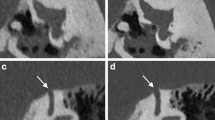Abstract
To evaluate the role of oVEMP and multidetector CT scan in patients with superior canal dehiscence syndrome. Prospective study was conducted on nine patients with superior canal dehiscence syndrome (5 females, 4 males) age ranged 19–49 with mean age of 32.7 ± 9.3 years, complaining of intolerance to loud sounds and/or oscillopsia. The mean duration of illness was 18.7 ± 6.9 months, nine normal individuals as control (age and gender matched) were also included in the study. All of them underwent oVEMP and MDCT scan. Patients were of bilateral normal hearing sensitivity with no conductive impairment. All of the studied subjects (patients and controls) had identifiable contralateral oVEMP responses. MDCT scan showed dehiscence in all the patients. The dehiscence was unilateral (n = 7) and bilateral [n = 2 the other ear had a defect of 2 mm and thus was excluded from the study for fear or false diagnosis of Superior semicircular canal dehiscence syndrome (SCDS)]. Unlike the normal subject (nI = 0.94 µV ± 0.03 and pI = −0.42 µV ± 0.09), with stimulation of the affected side in SCDS, there were augmented amplitude responses (nI = 2.64 µV ± 0.35 and pI = −3.10 µV ± 0.44) in the eye contralateral to the stimulus “contralateral to the lesion”. Mean oVEMP threshold for SCDS ears were 82.5 ± 7.55 dBnHL compared to 100 ± 5.77 dBnHL of the control ears. We concluded that combination of physiological and anatomical information from oVEMP and MDCT increased accuracy for diagnosis of dehiscence of superior semicircular canal.


Similar content being viewed by others
References
Colebatch JG, Halmagyi GM (1992) Vestibular evoked potentials in human neck muscles before and after unilateral vestibular deafferentation. Neurology 42:1635–1636
Colebatch JG, Rothwell JC, Bronstein A, Ludman H (1994) Click-evoked vestibular activation in the Tullio phenomenon. J Neurol Neurosurg Psychiatry 57:1538–1540
Murofushi T, Halmagyi GM, Yavor RA, Colebatch JG (1996) Absent vestibular evoked myogenic potentials in vestibular neurolabyrinthitis. An indicator of inferior vestibular nerve involvement? Arch Otolaryngol Head Neck Surg 122:845
Welgampola MS, Colebatch JG (2005) Characteristics and clinical applications of vestibular-evoked myogenic potentials. Neurology 64:1682–1688
Chihara Y, Iwasaki S, Ushio M, Murofushi T (2007) Vestibular-evoked extraocular potentials by air-conducted sound: another clinical test for vestibular function. Clin Neurophysiol 118:2745–2751
Iwasaki S, McGarvie LA, Halmagyi GM, Burgess AM, Kim J, Colebatch JG et al (2007) Head taps evoke a crossed vestibulo-ocular reflex. Neurology 68:1227–1229
Rosengren SM, McAngus Todd NP, Colebatch JG (2005) Vestibular-evoked extraocular potentials produced by stimulation with bone-conducted sound. Clin Neurophysiol 116:1938–1948
Welgampola MS, Migliaccio AA, Myrie OA, Minor LB, Carey JP (2009) The human sound-evoked vestibulo-ocular reflex and its electromyographic correlate. Clin Neurophysiol 120:158–166
Curthoys IS (2010) A critical review of the neurophysiological evidence underlying clinical vestibular testing using sound, vibration and galvanic stimuli. Clin Neurophysiol 121:132–144
Smulders YE, Curthoys IS, Burgess AM, Welgampola MS, Halmagyi GM (2007) Is the early negative component of the vestibular evoked myogenic potential (oVEMP) really the R1 component of the blink reflex? In: Proceedings of the Neurootology Society of Australia, p 14
Minor LB (2005) Clinical manifestations of superior semicircular canal dehiscence. Laryngoscope 115:1717–1727
Zhou W, Mustain W, Simpson I (2004) Sound-evoked vestibulo-ocular reflexes (VOR) in trained monkeys. Exp Brain Res 156:129–134
Karlberg M, Aw ST, Black RA, Todd MJ, MacDougall HG, Halmagyi GM (2003) Vibration induced ocular torsion and nystagmus after unilateral vestibular deafferentation. Brain 26:956–964
Todd NPM (2007) Estimated source intensity and active space of the American alligator vocal display. J Acoust Soc Am 122:2906–2915
Welgampola MS, Migliaccio AA, Myrie OA, Minor LB, Carey JP (2009) The human sound-evoked vestibulo-ocular reflex and its electromyographic correlate. Clin Neurophysiol 120:158–166
Rosowski JJ, Songer JE, Nakajima HH et al (2004) Clinical, experimental, and theoretical investigations of the effect of superior semicircular canal dehiscence on hearing mechanisms. Otol Neurotol 25:323–332
Rosengren SM, Aw ST, Halmagyi GM, Todd NP, Colebatch JG (2007) Ocular vestibular evoked myogenic potentials (OVEMPs) in superior canal dehiscence. J Neurol Neurosurg Psychiatry 118:381–390
Welgampola MS, Rosengren SM, Halmagyi GM, Colebatch JG (2003) Vestibular activation by bone conducted sound. J Neurol Neurosurg Psychiatry 74:771–778
Welgampola MS, Myrie OA, Minor LB, Carey JP (2008) Vestibular evoked myogenic potential thresholds normalize on plugging superior canal dehiscence. Neurology 70:464–472
Halmagyi GM, Carey JP (2010) Vestibular evoked myogenic potentials—we live in interesting times. Clin Neurophysiol 121:631–633
Chien W, Carey J, Minor L (2011) Canal dehiscence. Curr Opin Neurol 24:25–31
Nadgir R, Ozonoff A, Devaiah A, Halderman A, Sakai O (2011) Superior semicircular canal dehiscence: congenital or acquired condition? Am J Neuroradiol 32:947–949
Ceylan N, Bayraktaroglu S, Alper H, Savaş R, Bilgen C, Kirazli T et al (2010) CT imaging of superior semicircular canal dehiscence: added value of reformatted images. Acta Otolaryngol 130:996–1001
Author information
Authors and Affiliations
Corresponding author
Rights and permissions
About this article
Cite this article
Thabet, E.M., AbdelKhalek, A. & Zaghloul, H. Superior semicircular canal dehiscence syndrome as assessed by oVEMP and temporal bone computed tomography imaging. Eur Arch Otorhinolaryngol 269, 1545–1549 (2012). https://doi.org/10.1007/s00405-011-1893-3
Received:
Accepted:
Published:
Issue Date:
DOI: https://doi.org/10.1007/s00405-011-1893-3




